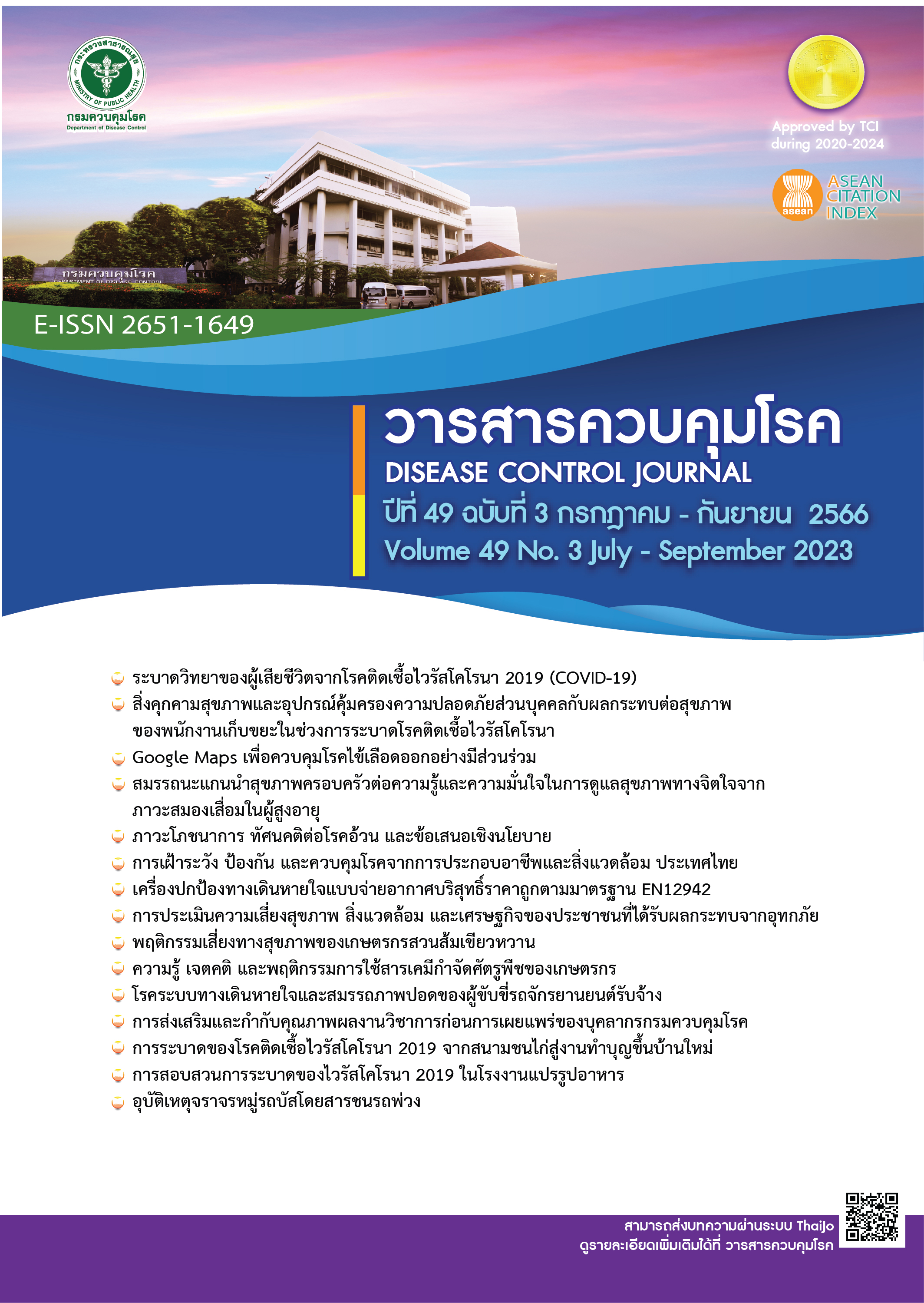Application of Google Maps for participatory control of dengue haemorrhagic fever: a case study of Ban Nongnaikhui community, Khlonghae sub-district, Hat Yai district, Songkhla province
DOI:
https://doi.org/10.14456/dcj.2023.43Keywords:
Google Maps, dengue haemorrhagic fever control, participatory action research, village health volunteersAbstract
Based on Dengue Haemorrhagic Fever (DHF) situation report, in 2019, Village Group No. 6, Ban Nongnaikhui Community, Khlonghae sub-district, had registered the highest DHF morbidity rate of 673.19 per 100,000. The research team has been interested in developing the guidelines for utilizing Google Maps for the purpose of DHF control through participatory action research (PAR) among sixteen core village health volunteers (VHVs). Demographic data, indicators for DHF control (i.e., mosquito larva indexes), knowledge, attitudes, and behaviors towards Google Maps, including satisfaction after Google Maps usage were collected through semi-structured interviews during October 1, 2019 to February 15, 2020. Data were analyzed using descriptive statistics and content analysis. Results of the study indicated there were four phases including Phase 1: Planning: It was found that different types of containers are not mentioned in mosquito larvae survey forms; most of the VHVs had poor knowledge of Google Maps but had positive attitudes in its usage; Phase 2: Action: All VHVs had attended the workshop and were able to apply Google Maps quite well; they could read and interpret the larva indexes correctly; Phase 3: Observation: Almost all VHVs were able to use Google Maps in spotting both passive and active DHF cases; until no new cases were found; they could send the information back faster compared to the previous time that took time about 1 day (about 30 minutes early); Phase 4: Reflection: All VHVs were satisfied and had higher skills with Google Maps usage, and a decrease in DHF cases was observed. In conclusion, to achieve a successful program implementation, Google Maps seems to be a beneficial tool that is feasible in DHF control efforts through participatory approach in all
procedures.
Downloads
References
Ministry of Public Health (TH), Department of Disease Control. Dengue Infectious Diseases and Dengue Guide to Medicine and Public Health; 2015. Nonthaburi: Department of Disease Control; 2015. (in Thai)
Jenjira C, Patipat V, Narong C, Somchai J. Epidemiological Trends of Dengue Hemorrhagic Fever in Phrae Province, 2009-2018. Lanna Public Health Journal. 2020;16(2):25-35. (in Thai)
Sommhay K. Motivation Affecting Participation in Dengue Hemorrhagic Fever Prevention and Control of Village Health Volunteers of Seutao Sub-District, Chiangyuen District, Mahasarakham Province. Academic Journal of Mahasarakham Provincial Public Health Office. 2020;4(7):180-93. (in Thai)
Hat Yai Hospital. Dengue Haemorrhagic Fever Situation in Hat Yai District, Songkhla Province, Summary of 1 January-31 December 2019. Songkhla Province: 2020. p. 1-16. (in Thai)
Department of Disease Control, Ministry of Public Health. Dengue Haemorrhagic Fever Prognosis Report; 2019. (in Thai)
Ministry of Public Health (TH), Department of Disease Control. Guidelines for conducting surveillance, prevention, control of mosquito-led diseases For Health Workers; 2021. (in Thai)
Kemmis S, McTaggart R. The Action Research Reader. 3rd ed. Geelong: Deakin University Press; 1988.
Ministry of Public Health (TH), Department of Disease Control. Operational Guide Dengue Hemorrhagic Fever FY2020; 2020. (in Thai)
Thanom N, Sukanya K, Somporn J, Man S, Janya D. Development of Surveillance System and 3-3-1 Measure Monitoring for Dengue Control Using Application on Google Drive, Yasothon Province, Thailand. Journal of Health Science. 2019;28(3):402-10. (in Thai)
Siriporn W, Pajongsil P, Saisamon S, Ratnaris S, Supachoke Y. Participatory use of Google Maps Khlonghae for Dengue Haemorrhagic Fever Control Case Study: Ban Nongnaikhui Community, Khlonghae Sub-district, Hat Yai District, Songkhla Province. Sustainable Health Development Post Covid-19 Pandemic Crisis; 2022 Sep 14-16; Songkhla Province. 2022. p. 1-8. (in Thai)
Wattanapurk S, Perngmark P, Smotantawee S, Suwanrat R, Yodkaew S. Google Maps Application in Controlling Dengue Hemorrhagic Fever with Community Health Volunteers at Khlonghae Sub-District, Hat Yai City, Songkhla Province: Participatory Action Research. International Conference: “Enhancing Continuity of Care Through the Science and Art in Nursing and Midwifery”; 2022 Oct 7-8; Songkhla Province. 2022. p. 1-254.
Buddhajak C, Archin S. The Use of Geographic Information Systems (GIS) in Public Health. The Southern College Network Journal of Nursing and Public Health. 2019;6(3):229-36. (in Thai)
Weerapat A, Wei-che Wang, Kedwadee S. Technology Acceptance related to usage of GOOGLE MAPS application. Transition to The Thailand 4.0 Era; 2018 Jan 18; Chiang Rai Province. 2018. p. 1-21. (in Thai)
Downloads
Published
How to Cite
Issue
Section
License
Copyright (c) 2023 Disease Control Journal

This work is licensed under a Creative Commons Attribution-NonCommercial-NoDerivatives 4.0 International License.
Articles published in the Disease Control Journal are considered as academic work, research or analysis of the personal opinion of the authors, not the opinion of the Thailand Department of Disease Control or editorial team. The authors must be responsible for their articles.






